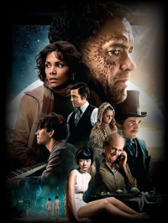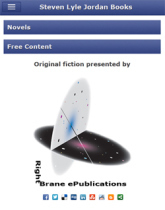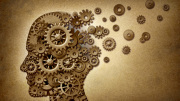Steven Lyle Jordan's Blog, page 62
November 26, 2012
Biometrics are in our future
 Though many have doubts that biometric technology will become the prevailing ID technology of the future, replacing passwords and PIN numbers… it’s already being rolled out. In some places, it’s been active for a decade.
Though many have doubts that biometric technology will become the prevailing ID technology of the future, replacing passwords and PIN numbers… it’s already being rolled out. In some places, it’s been active for a decade.
Palm vein ID technology, a system most Americans are not yet familiar with, has been gaining in usage and popularity abroad, and now beginning to reach domestic shores. Palm vein technology uses an infrared scanner to identify the veins inside one’s hand, compare it to a complex algorithm of data points, and okay (or decline) the user. The system has been tested extensively, demonstrating a .0001% error rate in over 75,000 user tests. (More info here and here.)
Palm veins are more secure than fingerprints, since they can’t just be lifted off of a surface like fingerprints; and only a living hand can be properly read, since the system depends on properly-flowing blood to work. Also, the system is a tenth the cost of retinal scan technology, considered the gold standard in biometric systems.
Palm Vein tech has been used in Japanese ATMs for the past decade, with great success, eliminating the need for easy-to-lose-or-steal PIN numbers. It is now being studied by the U.S. Army to identify individuals for payroll, and other organizations are looking at it to replace barely-effective and very insecure PIN-based systems. And lest you think it won’t hit U.S. shores, the tech has already been rolled out at a school in Louisiana, where students use the scanner to identify themselves to pay for school lunches.
There is still a great deal of resistance to any accurate ID technology in the U.S., where many citizens are convinced they will ultimately lose their privacy protections wherever they go. These citizens maintain that biometric tech will never make inroads in the U.S.
But they’re not taking two things into account. One thing is the fact that the technology is being broken in with people who are not in a position to avoid it. Army troops and school students must do what their leaders or adults tell them (though, in Louisiana, the parents—not the students—can opt out of the system), so they will soon get used to using the technology. It has been demonstrated, time and again, that once people are used to a technology, they are less likely to resist using it in the future. And breaking the young into technology early makes it a guaranteed lock-in by the time they are adults.
The other thing tech dissenters are not taking into account is the willingness of the public to accept a technology, when there’s something attractive in it for them. Take, for example, computer cameras: Years ago, the idea that a camera might be mounted on your computer, potentially watching you while you did—well, everything—seemed insane to even suggest to people. Yet, today, with the advent of free phone services like Skype, and various social media systems, more people have live cameras (and microphones) on their computers and laptops, often on 24/7, than anyone would have guessed.
People value the convenience of cellphone technology and the many apps they can use, so they forgo their concern of being trackable at all times. People accept companies storing their personal information and credit card data, so they can make one-click purchases. People will willingly enter minute details of personal data for a one in one million chance of winning a DVR. The public is willing to sacrifice privacy for a good enough incentive; and often, that incentive doesn’t have to be that good.
So: Imagine a prominent bank in the U.S. that makes palm vein scanners available to those who use ATMs, offering no banking fees for use. Imagine Starbucks or Best Buy allowing frequent customers to zip in and out, using palm vein tech to identify them and debit their accounts. Imagine a computer game store that allows customers to store data on games they’ve bought or tried, matches them with other online users and suggests new games to them as they are released.
You should begin to see how easy it would be to roll out this technology, nationwide, in no time.
Personally, with the ever-growing threats to personal security, data protection and financial records posed at every store, ATM and credit card transaction, it amazes me that Americans haven’t woken up to the potential disaster they risk simply by leaving their home every day, and demand better protection of their privacy through better security ID systems. Even now, the government warns Americans that we are in imminent danger of a digital “Pearl Harbor,” an attack on our digital data that could potentially wipe us all out of our data and cause widespread chaos that might not be fully recoverable.
But, Americans being who they are, I suppose they won’t act until the digital “Pearl Harbor” actually happens, and citizens lose millions, maybe billions of dollars to insecure and easily-hacked systems. At that point, they’ll be kicking at the doors to Congress, demanding to know where their God-given security is.
See also: Digital security: Think Biometrics


November 20, 2012
Cloud Atlas: Doomed to fail in the U.S.?

Cloud Atlas (Warner Brothers)
Cloud Atlas, the new Warner Brothers movie, seems at first glance to be everything a movie should not be in the U.S.: It has an intelligent story; it doesn’t feature any action heroes; the major romantic interests in the story all fail; and part of the storyline takes us into the future, automatically insuring an entire host of potential viewers will dismiss the movie as sci-fi right off the bat, and avoid it like the plague.
In fact, so far the most vocal complaints about the movie have been either about a lack of understanding of the story or a complaint about the heavy use of prosthetics to turn the lead actors and actresses into different people, different personalities, different races, and even different genders, running from storyline to storyline.
The criticisms about the story—actually, multiple stories tied together by some common thread that links them all together—is not hard to grasp. All it really takes to understand Cloud Atlas is the ability to enjoy a series of good stories and to pay attention, to see the common threads that bind the stories together. Yes, some are more obvious than others, and some (in the movie, at least) barely have an influence on the story itself… but they are there. (To easily examine the common threads and many characters in Cloud Atlas, I highly recommend Your Guide to the Characters and Connections of Cloud Atlas. You’re welcome.)
To be sure, the jumping from story to story, forward and backward in time, can take getting used to. Personally, I didn’t like the way the process was used in Pulp Fiction. On the other hand, I thought it was used perfectly in Lost. Cloud Atlas takes similar effort to keep track of the pieces, but it’s not that difficult… especially to those who have grown up watching flashback-heavy television programs.
As to the complaints about race- and gender-bending acting: It was a daring move for the Wachowskis and Tom Tykwer to use the same actors in multiple storylines, as an attempt to make it easier for the audience to connect the common souls in each story. Why daring? Not because of its artistic merit: The method is poetic, familiar to audiences and very effective. It has a time-honored tradition in theatre and movies, where visual shorthand is the established norm, in fact, a vital part of the effectiveness of movies and theatre.
No, it was daring because it was presented to a U.S. audience that is hyper-sensitive to race and gender relations. Thanks to centuries of socio-racial class warfare, Americans fret incredibly about the mere suggestion that one race or gender is not considered as good as another race and gender. Many viewed Cloud Atlas‘ use of European men, for instance, given stereotypical (and very unrealistic) folds over their eyes to play Korean men, as a suggestion that Korean actors weren’t good enough for those roles.
In obsessing over this detail, audiences will completely miss the point being created by the directors, and so will miss the point of the movie. They are reacting much like a modern moviegoer who, presented with Citizen Kane, is too obsessed with the lack of color to pay attention to the story or the incredible visuals on screen.
Unfortunately, the majority of the U.S. moviegoing audience constantly, consistently prove themselves to be exactly that superficial. They will line up for The Expendables 2, but will turn up their noses at a story with substance and intelligence. And in fact, Cloud Atlas has already been considered a bomb at the box office, and has been relegated to late night showings in the multiplex theatre room in the back with maybe forty seats and whose screen is not much bigger than your home TV.
Does that mean Cloud Atlas is a failure? Only if box office figures are the only thing you care to measure. In terms of artistic merit, Cloud Atlas has accomplished an incredible feat, trying together a half-dozen disparate stories, linked by slender but often significant threads, and played across the eras by the same actors, into a wonderful mosaic and a beautifully-crafted movie. Avoiding this movie would be doing yourself a serious disservice.
Fortunately, there’s always the aftermarket, where DVD sales have often proven to be the big money-maker over theatre sales. And as audiences get the chance to re-watch Cloud Atlas, and to better understand the stories and their connections, they may come to understand how incredible the movie is… and how unfounded the criticisms are.


November 11, 2012
Relevance in the modern era, with spies… and SF

Skyfall, courtesy MGM and Columbia Pictures.
The latest James Bond movie, Skyfall, may not be Bond’s sexiest, over-the-top adventure yet, but it might be his most vital: The theme of the movie is relevance… old vs new… and Bond’s place in the post-Cold-War era. M and MI6 are similarly attacked—literally and, apparently, easily—as the villain applies the latest computer tools to the old-school organization, and brings into question whether or not this stodgy organization, and its spies, can keep up with the modern era.
My spoiler-free review, for what it’s worth: Skyfall does an excellent job of answering the question, showing us a Bond that’s had hard knocks (what else is new?), but manages to keep coming back. We still have great Bond stunts, fights and chase scenes. The villain is done over-the-top-style, but fits well into the story’s theme. And we get a rare glimpse into Bond’s past—his own past, not just the appearance of the Astin Martin DB5 (which actually has only a minor role in the film). In fact, the post-Cold-War issue has always been a part of the Bond movies, but never directly addressed as clearly and succinctly as it was here. I highly recommend the movie, especially to those who wonder about the future of the franchise.
James Bond isn’t the only one concerned about relevance in a world that seems to be developing beyond his original purview. Science Fiction is having similar issues. As the world grows up, as science develops, people are coming to realize that the likelihood of meeting aliens like us (or, for that matter, any aliens at all) is increasingly remote; that we won’t be sailing from star system to star system as easily as boarding a luxury liner; that exotic transporters, energy weapons, Earth-like planets and exciting star wars aren’t likely to be in anyone’s future. The cool stuff that SF has shown us over the years is now considered silly and old-hat.
As well, we’re coming to grips with technology that seems to be outrunning us today: Computers have shrunken to palm-sized, and have begun to fool some people into thinking they are sentient; our cars can track traffic patterns that affect our route, and soon may be doing the driving for us; increased communications with our friends and relatives give rise to concerns about complete strangers tracking us and threatening our privacy. The worlds of SF seem to be upon us today. So what do we need SF for?
The Bond franchise has always been known for its trappings (which featured many of the same trappings as SF); and at times, it seemed the trappings were all that was really there. But there has always been a deeper level to Bond films. Bond was never about just the gadgets; at heart, James Bond is about applying a combination of the latest tools and his extraordinary skills at endurance, combat, psychology and intelligence to troubleshooting and foiling threats to the common good, whether they were political, financial or scientific.
Psychology and intelligence were always common to Bond: His ability to read and outguess his opponents, to divine their plans and work out counter-plans on the fly, were as important as his toys and his ability to outrun an explosion. This is what continues to make Bond relevant: Not just his physical capabilities, but his unique knowledge of human behavior and capabilities, and his finely-honed intelligence and strategic skills.
Science Fiction is likewise commonly known by its trappings: The utopias and dystopias; the spaceships and rayguns; the green-skinned Orion women and the acid-blooded aliens; the androids and sentient computers. But SF has always been much more than that. SF is at its best when it uses those trappings as ways to explore human reactions to them, to see how they impact individuals and groups… what they mean to personal and communal development.
Stanislaw Lem’s Solaris, for one example, could have simply presented us with a planet that created copies of people out of the scientists’ pasts, and that would have been it; instead, the people created by the planet were directly related to traumatic moments in the scientists’ lives, forcing them to revisit painful memories and reconsider their deepest beliefs about life, love, responsibility and compassion.
The rebooted Battlestar Galactica is another good example of the heart of SF: It outright abandoned most of the physical detritus of SF, keeping only the spaceships and the concept of sentient robots; and in so doing, presented viewers with a much clearer view of an old morality tale, involving race, prejudice and paranoia, psychology and relationships. Galactica has become one of the most celebrated SF television shows, primarily by removing the set dressing and putting a tight focus on human relevance.
That is Science Fiction at its best: Seeing past the trappings, and exploring what they mean to the people; examining the impact on society and on individuals; considering the future of our development, and whether that future will be better or worse for us. Science Fiction is never about the gadgets—it’s about the people who use them and are impacted by them. The future of SF will be its ability to find the human relevance of science and future trends, and to present that to its audience. And as long as it can continue to do that, it will remain a part of our culture.


November 8, 2012
Imagine China as the global superpower
 A recent IO9 article explores the concept of China as the future superpower of the world, over the U.S. or any other nation. The article mostly touches on attempts to explore those ideas in books, movies and television… though it doesn’t get too deeply into the things that could bring about such a situation, nor judge the desirability of such a future. In most cases, writers have used a present-brush to paint the future, and in so doing, have neglected a great swath of the possible palate of colors.
A recent IO9 article explores the concept of China as the future superpower of the world, over the U.S. or any other nation. The article mostly touches on attempts to explore those ideas in books, movies and television… though it doesn’t get too deeply into the things that could bring about such a situation, nor judge the desirability of such a future. In most cases, writers have used a present-brush to paint the future, and in so doing, have neglected a great swath of the possible palate of colors.
China’s recent and rapid growth and development, combined with the problems being faced by the West, have prompted many writers to speculate that China may eventually overtake the existing superpowers—namely, in most cases, the U.S.—and take the position of dominant social, political and financial force in the world. Most of the treatments given in media have either been very subtle, or have taken advantage of most of the Western stereotypes regarding Eastern culture, and have tattooed one over the other in a rather gross fashion.
As usual, the truth will certainly be somewhere in-between. Just as the West has been influenced by certain areas of Eastern culture (which, it must be noted, is as varied as there are Eastern nations), so China has been, and is being, influenced by Western culture. And neither side’s cultures are static: They evolve, sometimes sensibly, sometimes chaotically, depending on many social, political, financial and social factors and events. At a future point in which China becomes the dominant superpower, it might not look that different than the West… or it might look like nothing recognizable to the Easterners, or the Westerners, of today.
For that matter, the very concept of superpower-nations is rapidly evolving, as interests become more globally-influenced, and nations have to come to grips with the reality that “no man is an island.” Once of China’s greatest challenges, right now, is how to accelerate and advance their industrial base while dealing with the rampant pollution of their air, ground and water that has so challenged the West. Their solutions so far have been a combination of internal innovation, authoritarian control, PR whitewashing and international solution-shopping, the results have been predictably mixed, and the ramifications will have global impact.
Technology is another area in which China finds itself in a perpetual embrace with the rest of the world: Between manufacturing products for other countries, and creating knock-offs of other countries’ products for themselves, China is trying to play both sides of an international commerce game, selling legitimately on one hand while cheating with the other. As they become more involved with the global market, they will have to deal with a world that will be increasingly intolerant of underhanded dealings, and force them to play fair. Or they will have to consider their own action to force the matter. If this attitude doesn’t change, China may not be in a position to dominate anyone, as an entire world’s resistance can be too much to overcome.
And finally, communications are rapidly homogenizing the planet, spreading ideas, wealth and influence over an ever-increasing area and changing the face of internationalism and global politics. If, as some suggest, the Industrial Revolution will eventually be replaced by the Information Revolution, we may not even have superpower-nations in the future, and the very idea of one geographical region dominating the rest of the world may become ludicrously quaint.
More likely, we’ll continue to see the growing inter-cultural mixing centered in the U.S. and spreading to other countries and cultures. This mixing has often taken the form of instilling American culture on other countries… but not always; and, of course, as American culture is by nature a mixing of other cultures into our own, American culture is in fact a Global culture, mixing and matching the best of all cultures and presenting it back to the world to use as it will. And much of China’s culture is made up of some of that American cultural remix.
So: Chinese global domination? It could happen… if at all, it would have to be soon, while there are still countries in a position to dominate. But even if it does happen, it may be a domination in name only; and at street level, it may be almost impossible to tell.


November 6, 2012
Announcement: Right Brane is now mobile.
 Announcing the official unveiling of the Right Brane mobile website!
Announcing the official unveiling of the Right Brane mobile website!
Yes, RightBrane.com now has a mobile component, and anyone going to the RightBrane site from a smartphone or other portable device should be taken directly to our mobile pages. Designed and produced (by me) to facilitate ease of use on small devices, the mobile site includes all of my novels and free content, information about the books, and the same multiple ebook formats and easy buying methods as before.
As the mobile site is just opening, I may be tweaking it further as time goes by, and especially if I get any comments as to its functionability. It does not have all of the pages that the full site carries, but there are links taking you back to the full site if you need that info.
So please check out the mobile site, and use the social media icons to share the pages with your futurist-fiction-loving friends (and anyone else you know who might pass it on to others). If you have questions or comments, you can post them here or contact me directly. Let me know what you think… and, as always, enjoy!


November 2, 2012
Developing the future of Sarcology

Steven Lyle Jordan
I always develop most of a novel’s setting before I start writing it, and allow the writing process to flesh out a few cool details along the way. As I’m currently hip-deep in my next novel, currently known by the project name of Sarcology, I’ve written most of those fine details, and find myself working in an environment that I can picture in my mind as if I’ve actually just returned from visiting there. So I thought I would spell out a few details, to prepare you for the world of my upcoming novel.
In the United States of the mid-twenty-first century, Atlanta (the story’s base) has become the financial and cultural center of the East Coast formerly occupied by New York City… partially because it has striven to take that place for decades, and partially because the iconic East Coast mecca had finally reached its practical limits, and has begun to lose the battle against bloat, decay, environmental punishment (from climate change and sea level rise) and the influence-deconcentration of the digital age.
(Ironically, the recent damage done to the New York City area by Hurricane Sandy highlights and foreshadows this trend, as it demonstrated NYC’s lack of preparedness for the more extreme weather and sea level rise that is becoming more common worldwide. But lest you see it as a coincidence that NYC’s troubles are reminiscent of the background of my story… I’d suggest that there is nothing coincidental about it.)
In this story, the pressures of privacy and safety have created an increase in the amount of security systems used nationwide, especially public and private surveillance systems, biometric ID systems and citizen databases. Biometrics, often used in conjunction with coded ID cards, have effectively replaced physical keys for access to almost every locked space or equipment. Naturally, for every increase in security came a demand, by some, for increased privacy; so, the nation is now a crazy quilt of very security-heavy areas, and areas that avoid or can switch off security systems to give users their privacy, and people tailor their activities around either security or anonymity.
It’s anybody’s guess how security will develop in the U.S., but I believe that all it will take is the right incentives, i.e., the right threats close enough to the right people, to push the nation as a whole over to seeking better protection for its individuals. That’s the way most security systems develop, when the majority demands protection over the concerns of the minority. Despite Ben Franklin’s assertions that those who surrender some freedoms in the name of security deserve neither freedom nor security, individuals under a perceived threat are more likely to agree to new, more restricting technologies for protection. Surveillance and biometric ID technology are easy guesses for the security tech of the future… we could see even more methods become commonplace in the future.
Automation plays a much greater role in the world; but as opposed to R2D2-like robo-maids flitting about every household, ala Michael Crichton’s Runaway, automation has been largely applied to major commercial and industrial uses, and of course, to war. The average person is most exposed to automation through the automobile, which now drives itself (no one manually drives a car near a major city), and through the more intelligent appliances and public systems surrounding them. Robotic drones of every type are also common, especially in security systems and delivery.
(Personally, I’d like to see America’s cars start driving themselves, and immediately bring an end to the largest single killer of Americans in this country. Speaking of giving up freedom for security…)
Personal electronics have, of course, become more ubiquitous and refined. Few people do not own a Personal Secretary, or persec, their own data storage and processor and personal organizer—the future version of today’s smartphone. Persecs themselves are usually worn on the ear, and can be voice-controlled; but users often opt to wearing wirelessly connected devices like wrist control devices, combining control surfaces and viewscreens to make interaction and communication easier. Larger persecs are still used in business environments, depending on the need and tasks performed. Persecs interact with any digital equipment owned by the user, as well as the control systems in cars, door locks, semi-public spaces (like the storage areas of your apartment building) and biometric ID systems.
The story revolves heavily around the Semi-Autonomous Robot, or SAR, generally (but not always) a humanoid mechanism used to take the place of humans in hazardous situations. Sars are often used in law enforcement and in ground warfare in place of human police and soldiers, especially in very dangerous areas. Sars can act independently, but can also be directed by a human operator remotely.
A new version of sar, the Slaved Semi-Autonomous Robot or S-SAR, offers a human operator a more immersive control system, wherein he can more easily control the actual movements of the robot, rather than simply providing gross direction to a sar… the S-sar is more like wearing a robot suit. And in the story, an S-sar being developed in one company becomes the target of corporate espionage by an unknown, taking the form of blackmailing one of the researchers to obtain its secrets.
The secrets largely involve the sophisticated composites used to create the S-sar, composites that take advantage of what may be the next wonder material of the age: Carbon. As scientists find new atomic structures for carbon, they are discovering more things they can do, from providing containers for other elements, to adding strength, flexibility, insulation, conductivity, carbon sequestration and a host of other features, often many at once. These structures, collectively known as Buckminster Fullerenes, may single-handedly revolutionalize the chemical and materials industries… as soon as we figure out how to manufacture them in bulk.
All this, of course, is background to the real story, which involves the ever-eroding line between humans and their robotic creations, and specifically how that impacts a very sexy and romantic couple, partners in a detective agency that get called in to stop the story’s blackmailer. Suffice to say that as the story develops, that line erodes even further, and the couple’s relationship will never be the same. Hopefully, your viewpoint will likewise never be the same.


October 11, 2012
Going mobile

Steven Lyle Jordan
A conference I recently attended showed me the incredible rate at which the mobile information space is growing, especially in the smartphone and tablet areas… and reminded me that although my site is workable on a mobile platform, I haven’t had a mobile-optimized website in quite some time.
So I’ll be spending my spare time working on a mobile version of my books site, and considering the possibility of a mobile app down the line.
The mobile website is a bit easier, since I already know HTML… it’s just (!) a matter of designing it. A mobile app is trickier, and likely more expensive, so I don’t know how likely it is that I’ll manage that. But we’ll see… one thing at a time.
(Don’t worry… I’m still writing!)


October 8, 2012
Machine consciousness is possible, but first, psychologists must define consciousness
 Quantum physicist David Deutsch has penned an article for Aeon Magazine that examines the concept that artificial general intelligence (AGI) on a par with human intelligence is possible, given the assumption that any physical model—even the very movements and actions of atoms—can be emulated by mechanical means.
Quantum physicist David Deutsch has penned an article for Aeon Magazine that examines the concept that artificial general intelligence (AGI) on a par with human intelligence is possible, given the assumption that any physical model—even the very movements and actions of atoms—can be emulated by mechanical means.
Deutsch discusses the Babbage Engine, and the fact that the only thing that prevented it from being able to emulate more of the human mind was its size and architecture. Its theoretical properties prompted Alan Turing to postulate that all aspects of consciousness could be emulated by a computer.
Unfortunately, the identification and definition of consciousness itself is still a mystery to scientists, a wall preventing us from taking the next step and designing a conscious computer. Deutsch suggests that it is the philosophers, not the scientists, who must step up and provide those definitions for us. And once we have them, it will be possible to create computers that must be considered “people,” as they will be as self-aware as people.
These theories will be touched on in my latest novel, a romantic adventure that delves into the relationships between humans and robots. The book is expected out in early 2013.


September 23, 2012
Robots, here I come.

Steven Lyle Jordan
I may be mere days away from committing the first organized state of electrons to file (colloquially known as “words to paper”) on my next novel, which will explore the concepts of relationships and identity between human beings and robots. And considering how long I’ve gone since my last major writing project, I find that as I get closer to the commitment point, I’m getting more stoked about it.
Robots have been a favorite subject of mine for years, but I’ve written so little about them… partially because so many others have said so much about them already, in literature and other media. My second novel was about a robot’s attempt to find a place for itself in the world, and its influence on the life of a human who inadvertently comes into contact with it (but don’t go looking for it: I’ve pulled it from circulation with the hope of doing a rewrite on it sometime). It was short, nothing groundbreaking, but it had the virtue of being original in its premise and approach, and I was proud of how it came out. (I really should do that rewrite.)
Robots have always been special subjects in literature, unique hybrids of machines, humans and alchemy (at first… later, computers replaced alchemy), providing an iconic method in which to examine the relationship between all of those elements. They have been treated, at equal times, as toasters, masters, slaves, aliens and gods. And the relationships between robots and humans have been just as vast, ranging from tool, to trusted friend, to mortal enemy. They may be the single more incredible invention Man has ever conceived, and the only one whose potential may surpass that of any living being. I mean, how amazing is that?
It’s no wonder I can’t wait to dive into that pool again. My new novel will also be told from the point of view of a human, and will feature some elements that are rarely seen in robot stories… but I don’t want to give any more of it away. Suffice to say, I plan to have fun with this one, and everyone might be pleasantly surprised with it when it’s done.


September 14, 2012
Am I becoming an iBorg?
 Last year, I won an iPad at the office Christmas party. I keep it at the living room sofa, my go-to device to check out online content that relates to the TV shows I’m watching… or, if the wife is watching something I’m not into, to call up and read digital comics.
Last year, I won an iPad at the office Christmas party. I keep it at the living room sofa, my go-to device to check out online content that relates to the TV shows I’m watching… or, if the wife is watching something I’m not into, to call up and read digital comics.
Last month, I bought an iPod Nano 6G. I was using my Droid cellphone to listen to music, but a constant problem with the audio jack forced me to seek an alternative. I wanted something that would take up very little space, allow me to find and play what music I wanted to play, occasionally scare up a radio broadcast (like when I wanted a news, traffic or weather report), and that was about it. This also means using iTunes to load music into the Nano.
So: I’m using an iPad, an iPod, and iTunes. Am I becoming an iBorg?
I know those who are so devoted to all things Apple that they evangelize ad nauseam about Apple products, and delight in snapping out “Get a Mac!” whenever the opportunity arises. And sometimes when it doesn’t. I call them iBorgs: They are well and truly assimilated. Some part of Steve Jobs still lives in their minds, and I’m sure their DNA is actively trying to rewrite itself to be more like his.
But would I say that I’m becoming another iBorg? That I am on the road to Apple adoration? I’d have to say No.
To begin with, I don’t adore the products I have. The iPad can be convenient, but it’s not as versatile as a laptop, it doesn’t share files with other devices as easily, and it’s lousy at multitasking. The iPod Nano is nice and small, but its insistence on loading through iTunes makes it kludgy. And as it turns out, it doesn’t like some MP3 files that other MP3 players are perfectly happy with, forcing you to convert the MP3 files to AAC files just for the Nano.
And did I mention iTunes? iTunes is a pain in the ass. It always has been. I use Winamp to play music around the office: It’s easier to load and unload songs, tag, manage, arrange and search, and its tools are easier to find and use. Any MP3 that plays in Winamp plays on any other MP3 player, without fuss. And I can transfer songs from one device to another without needing Winamp; I can pull them right out of my file manager.
Now, I realize that there are some people for whom Apple does fine for everything. When you use all of Apple’s devices, peripherals and authorized sales outlets, you tend to get everything working together fairly seamlessly. But for me, it’s unrealistic to buy and use everything from the same vendor, because that vendor’s products don’t allow you to do everything you want, in the way you want it. Apple works hard to control your computing experience… and that’s too much control for me.
After about a week of futzing, I finally got the Nano to work as desired, replacing the many files that were corrupted upon transfer from iTunes. And the iPad finally stopped dropping my wifi connection when I upgraded the iOS. I’m satisfied.
But am I converted? Have I swallowed the Kool-Aid? NO. No danger of my becoming an iBorg anytime soon.





